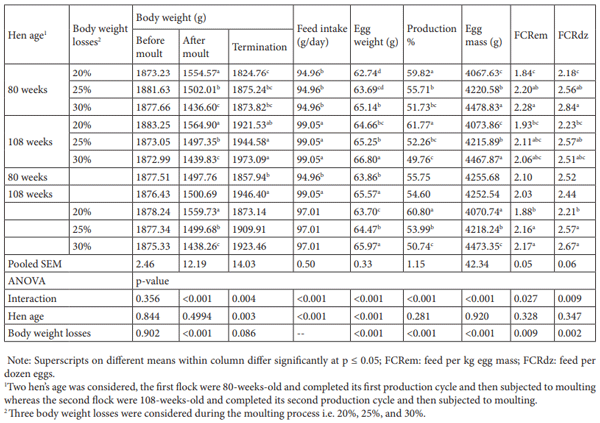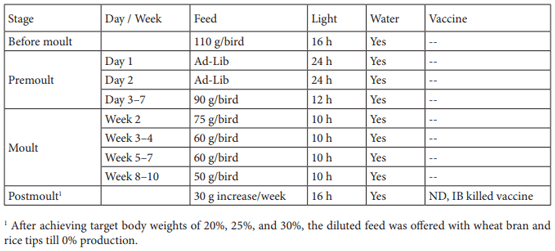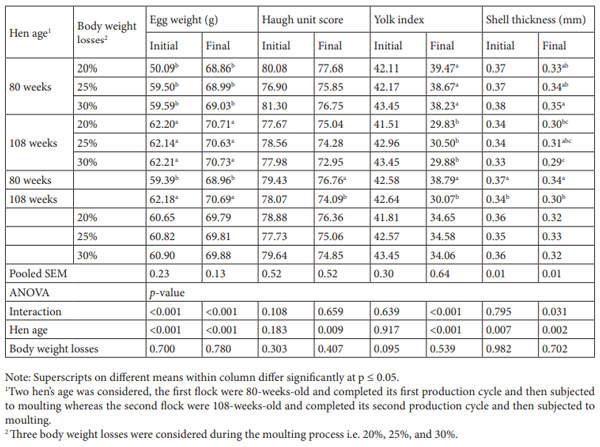1. Introduction
In Pakistan, the poultry production sector in the form of eggs and meat is playing a pivotal role in bridging the gap between the supply and demand of animal protein. Presently this sector is producing 1681.64 metric tonnes of meat and 16,797 million eggs and these figures are in a constant increase [1]. Previously, egg production was limited to the backyard poultry, where desi hens having little potential for this very economical trait were used. The addition of genetically improved commercial egg laying stocks especially during the last three decades has created a significant impact on overall egg production in the country [2].
In order to increase profits, the commercial egg industry mostly uses induced moult procedures to rejuvenate flocks for a second or third laying cycle. According to Bell [3], approximately 75% of commercial laying farmers in the United States use an induced moult program to rejuvenate flocks to enhance productivity. Executing an induced moult program can result in a 30% increased profitability for producers when compared with an all replacement pullet operation [3].
Forced moulting is a management tool and has been adapted for many years. Most of the researchers reported that induced moulting progresses the post moult performance of the laying hens compared to the premoult performance [4,5]. In a country like Pakistan, induced moulting is used in the poultry industry to enhance the reproductive lifespan of layers prominent to new laying cycles [6]. Forced moulting also helps to prevent age-related declines in egg production and egg shell quality [7]. Moult induction by the withdrawal of feed is the most common and widely practised method in the poultry world [8]. Generally, an increase in productive performance was reported after the regeneration of body tissues during the rest phase of moulting [9]. Feed intake is a major factor affected by body weight loss during moulting, and studies reported that hens with a 35% body weight loss during moult consumed significantly higher feed compared with hens with only a 25% body weight loss [10]. In contrast, some scientists [11] also reported that feed consumption did not differ in the post moult period among different body weight loss categories. As far as the relationship of egg production with body weight loss is concerned several studies [11,12] have reported no effect of body weight loss during moulting on egg production. On the other hand, a positive association between body weight loss and egg production has also been reported [13].
To improve egg quality and production in older hens, the farmer usually uses a moulting procedure that regresses the reproductive organs and then regrows the ovary and oviduct [8]. To achieve better egg production, egg size, and shell quality during postmoult optimum body weight reduction and length of the resting period are the major criteria. As genetics of the commercial layer is on a constant change. Thus, body weight loss (%) during moulting of genetically modified strains in different production cycles needs to be optimized from time to time. So, the present study has been planned to evaluate the effects of hen’s age and body weight losses during moulting on productive performance, egg quality, and immune response.
2. Material and methods
The trial was conducted at commercial layer farm Din Farm Products (Pvt) Ltd located at Jumber, Kasur, Pakistan.
2.1. Experimental birds
A total of 324 birds of Lohmann Selected Leghorn Lite from two hen ages were subjected to experimentation to evaluate the effect of age and body weight loss during moulting on post moult production. The birds were distributed into two hen ages i.e. 80 and 108 weeks and were distributed into three body weight categories i.e. 20%, 25%, and 30% body weight losses during moulting. The experiment was set up as a completely randomized experimental design under the 2 × 3 factorial arrangement of treatments having 6 replicates of 9 hens each. The 80-weeks-old hens were moulted at the age of 64 weeks, whereas the 108-weeks-old hens were first moulted at the age of 64 weeks and then 108 weeks. The birds were moulted for 6 weeks and their postmoult performance was evaluated for the next 12 weeks.
2.2. Bird’s ethics
All the procedures performed in this study were in accordance with the ethical standards of the University of Veterinary and Animal Sciences, Lahore, Pakistan, and approval was granted by the Animal Ethical Review Committee (DR: 236; 21-12-2020).
2.3. Bird’s husbandry
The birds were placed in the commercial prefabricated poultry farm having a measurement of 480 × 50 × 22 feet, installed with a computerised controllable system of feed, water, cooling and heating. The hens were kept in Turkish made Kutlusan “ECO-64” cage units having dimensions 2.1 × 2.1 × 0.8 feet. Each cage had 9 birds in it having 0.49 sqft space per bird. The birds were moulted through light and feed restriction and feed allowance was gradually reduced (for details see Table 1). During the postmoult production phase, the birds were fed with a laying diet prepared according to Lohmann Selected Leghorn (LSL) Lite strains’ standard feeding requirements.
2.4. Parameter evaluated
Below mentioned parameters were observed to evaluate the productive performance of layer hens:
Feed intake (g): A feed ration of 120 g per bird was offered in feed troughs and residual feed was weighed to calculate actual feed intake with the help of the following formula:
Feed intake (g) = Feed given (g) – Remaining feed (g)
Body weight (g): it was recorded at three stages i.e. at the start of moult, at the end of moult and the termination of the experiment. Initially, body weight of each bird was recorded based on two age groups (80 and 108 weeks), then all the birds were subjected to moulting procedure through feed and light restriction; after moulting, body weight of every bird was recorded again and distributed into three categories based on body weight losses during moulting i.e. 20%, 25%, and 30%.
Egg production (%): egg numbers laid in 24 h of each experimental unit was counted and daily egg production % was calculated with the help of the following equation:
Egg weight (g): the weight of each egg was noted daily by using a digital weighing balance having the capacity of measuring up to 0.1 g.
Egg mass (g): the weight of all eggs laid by each replicate during the experimental period of three months were added to calculate egg mass.
Feed per dozen eggs: It was considered by dividing the total feed consumed by dozens of eggs produced according to the following formula:
Feed per kg egg mass: it was determined by dividing the total feed taken by the total egg mass produced during the experimental period.
Table 1. Moulting schedule of experimentation birds.
Egg quality traits were evaluated at the termination of the experiment. A total of 9 eggs were picked from all replicates and were subjected to egg quality traits. The following parameters were calculated:
Egg weight: each egg was weighed by using an electrical weighing balance having a capacity of measuring up to 0.1 g.
Haugh unit score: by measuring egg weight and albumen height Haugh unit score [14] of the individual egg was calculated with the help of the following formula:
Haugh unit =100 Log [(H + 7.57) – (1.7) (W0.37)], where
H = observed height of the albumen in mm, W = weight of egg (g).
Yolk index: by measuring yolk height with spherometer (least count = 0.1cm) and yolk width with the digital Vernier callipers yolk index was calculated by using the following equation [15]:
2.5. Statistical analysis
Data were analysed through factorial ANOVA using PROC GLM in SAS software (Version, 9.1.3). Significant treatment means were separated through Duncan’s multiple range test considering p ≤ 0.05. The following mathematical model was applied:
Yijk = µ + αi + βj + (α × β)ij + ϵijk , where
Yijk= observation of dependent variable recorded on ith and jth treatment groups,
µ = population mean,
αi = effect of ith hen age (i = 1, 2; 80 and 108 weeks), βj = effect of jth body weight loss (j = 1, 2, 3; 20, 25, and 30%),
(α × β)ij = interaction effect between ith and jth treatment groups,
ϵijk = residual effect associated with ith and jth treatment groups NID ~ 0, σ2.
3. Results and discussion
Results of effects of hen age and body weight losses on productive performance of commercial layer hens are shown in Table 2. Commercial layer hens showed a significant effect of body weight losses (p ≤ 0.05) and their interaction (p ≤ 0.05) on body weight (Table 1). Body weight of commercial layer hens before moult was not affected by hen age; however, postmoult body weight was significantly higher in hens of 80 and 108 weeks age with 20% (p ≤ 0.05) body weight loss compared to the hens with 25% and 30% body weight losses. Body weight at termination was higher in hens of 108 weeks age with 25% and 30% body weight losses compared to hens of 80 weeks age with 20%, 25%, and 30% body weight losses. In age-wise comparison, termination body weight was significantly higher (p ≤ 0.05) in hens of 108 weeks age compared to the hens of 80 weeks age. Commercial layer hens showed a significant effect of age (p ≤ 0.05) and its interaction (p ≤ 0.05) on feed intake (Table 2). Feed intake was significantly higher (p ≤ 0.05) in hens of 108 weeks age with 20%, 25%, and 30% body weight losses compared to hens of 80 weeks age with 20%, 25%, and 30% body weight losses. In age-wise comparison, feed intake was significantly higher (p ≤ 0.05) in hens of 108 weeks age compared to the hens of 80 weeks age. However, body weight losses of hens did not affect feed intake. Commercial layer hens showed a significant effect of age (p ≤ 0.05), body weight losses (p ≤ 0.05), and their interaction (p ≤ 0.05) on egg weight (Table 2). Egg weight was significantly higher (p ≤ 0.05) in hens of 108 weeks age with 30% body weight losses compared to hens of 108 weeks age with 20% and 25% body weight losses, and 80 weeks age with 20%, 25%, and 30% body weight losses. In age-wise comparison, egg weight was significantly higher (p ≤ 0.05) in hens of 108 weeks age compared to the hens of 80 weeks age. In a comparison of body weight losses, egg weight was significantly higher (p ≤ 0.05) in hens with 30% body weight losses compared to the hens with 20% and 25% body weight losses. Commercial layer hens showed a significant effect of body weight losses (p ≤ 0.05) and their interaction (p ≤ 0.05) on production percentage (Table 2). Production percentage was significantly higher (p ≤ 0.05) in hens of 80 weeks and 108 weeks age with 20% body weight losses compared to hens of 108 weeks and 80 weeks age with 25% and 30% body weight losses. However, hen age did not affect production percentage. In a comparison of body weight losses, production percentage was significantly higher (p ≤ 0.05) in hens with 20% body weight losses compared to the hens with 25% and 30% body weight losses. Commercial layer hens showed a significant effect of body weight losses (p ≤ 0.05) and their interaction (p ≤ 0.05) on egg mass (Table 2). Egg mass was significantly higher (p ≤ 0.05) in hens of 80 weeks and 108 weeks age with 30% body weight losses compared to hens of 108 weeks and 80 weeks age with 20% and 25% body weight losses. However, hen age did not affect egg mass. In a comparison of body weight losses, egg mass was significantly higher (p ≤ 0.05) in hens with 20% body weight losses compared to the hens with 25% and 30% body weight losses. Commercial layer hens showed a significant effect of body weight losses (p ≤ 0.05) and its interaction (p ≤ 0.05) on FCR per egg mass and FCR per dozen (Table 2). FCR per egg mass and FCR per dozen were significantly higher (p ≤ 0.05) in hens of 80 weeks age with 30% body weight losses compared to hens of 80 weeks age with 20% and 25% body weight losses, and 108 weeks age with 20%, 25%, and 30% body weight losses. However, hen age had no effect on FCR per egg mass and FCR per dozen. In a comparison of body weight losses, FCR per egg mass and FCR per dozen were significantly higher (p ≤ 0.05) in hens with 25% and 30% body weight losses compared to the hens with 20% body weight losses.
Table 2. Effects of hen age and body weight losses during moulting on productive performance of commercial layer (12 weeks).

Effect of hen age and body weight losses of commercial layer hen on egg quality is shown in Table 3. Commercial layer hens showed a significant effect of hen age (p ≤ 0.05) and its interaction (p ≤ 0.05) on initial and final egg weight (Table 3). Initial and final egg weight was significantly higher (p ≤ 0.05) in hens of 108 weeks age with 20%, 25%, and 30% body weight losses compared to the hens of 80 weeks age with 20%, 25%, and 30% body weight losses. Layer hens of 108 weeks of age showed significantly higher (p ≤ 0.05) initial and final egg weight compared to the hens of 80 weeks of age; however, body weight losses did not affect initial and final egg weight. Haugh unit score showed no effect except hen age. Layer hens of 80 weeks age had significantly higher (p ≤ 0.05) final Haugh unit score compared to the hens of 108 weeks age. Commercial layer hens showed a significant effect of hen age (p ≤ 0.05) and its interaction (p ≤ 0.05) on the final yolk index (Table 3). The final yolk index was significantly higher (p ≤ 0.05) in hens of 80 weeks age with 20%, 25%, and 30% body weight losses compared to the hens of 108 weeks age with 20%, 25%, and 30% body weight losses. Layer hens of 80 weeks age showed significantly higher (p ≤ 0.05) final yolk index compared to the hens of 108 weeks age; however, body weight losses did not affect initial and final egg weight. Commercial layer hens showed a significant effect of hen age (p ≤ 0.05) for initial and final shell thickness and its interaction (p ≤ 0.05) on final shell thickness (Table 3). Final shell thickness was significantly higher (p ≤ 0.05) in hens of 80 weeks age with 30% body weight losses compared to the hens of 80 weeks age with 20% and 25% body weight losses, and 108 weeks age with 20%, 25%, and 30% body weight losses. Layer hens of 80 weeks of age showed significantly higher (p ≤ 0.05) initial and final shell thickness compared to the hens of 108 weeks of age; however, body weight losses did not affect initial and final shell thickness. The antibody response of commercial layer hen is shown in Table 4. Commercial layer hens did not show any response to Newcastle disease (ND), infectious bronchitis (IB), avian influence (H9 and H7), and Mycoplasma gallisepticum (MG). No effect of hen age, body weight losses and its interaction were observed on antibody response of commercial layer hens.
Table 3. Effects of hen age and body weight losses during moulting on egg quality traits of commercial layer.
Table 4. Effects of hen age and body weight losses during moulting on antibody response of commercial layer.

This study aimed to evaluate the effects of hen’s age and body weight losses during moulting on productive performance, egg quality, and immune response. This was successful, as several differences were observed during experimentation, which are important factors for optimum postmoult egg production, egg size, and shell quality. To improve egg quality and production in older hens, the farmer usually uses a moulting procedure which regresses the reproductive organs and then regrows the ovary and oviduct. To achieve better egg production, egg size, and shell quality during postmoult optimum body weight reduction and length of the resting period are the major criteria. Regarding body weight, 80- and 108-weeks-old hens with 20% body weight loss during moulting had the highest body weight followed by the hens of both ages reduced 25% and 30% body weight. However, at the termination higher body weight was noted in 108-weeks-old birds with 25% and 30% body weight reduction during moulting. The most likely explanation for this higher body weight is that they had reached their target weight in few days and had been maintained on the prelay feed, enabling a more rapid postmoult increase of the reproductive tract. Similarly, other studies supported that 25 to 30% body loss is mandatory for a significant reduction in uterine lipid.
The beneficial effects of moulting are termed rejuvenation; however, its mechanism of action is to reduce excessive adipose tissue and regress the reproductive tract of the bird [16,17]. The findings of present study correspond to the findings of Gordon et al. [10] who found higher postmoult body weight of 107-weeks-old Hy-Line W36 layer strain with 25% and 35% body weight losses.
In terms of feed intake, higher intake was observed in 108-weeks-old hens with 20%, 25%, and 30 % body weight losses and might be attributed to the bird’s age. It is a general fact that body weight increases with the advancement of age and ultimately requirement of feed increases. The findings of the present study are in accordance with the results of previous studies [18–20], who reported an increase in feed intake with the increase in age and body weight. However, contradictory findings reported that feed intake did not differ significantly with an increase in the age of birds [21,22]. Another study reported that 35% body weight loss group consumed higher feed intake as compared to 20% and 25% of body weight loss groups [10].
Interestingly, egg weight was higher 108-weeks-old hens with 30% body weight loss during moulting. The most probable bird loses 30% of their body weight meaning that all the fat deposited around the reproductive tract mobilize efficiently and improves egg formation. Similarly, another study [23] reported higher egg after moulting which ultimately enhances the percentage of albumen. Production percentage was higher in hens of both ages with 20% weight loss during moulting and this could be due to moderate body weight of birds which reduce less body weight and persist their egg production percentage even after moulting. Moreover, higher body weight loss during moulting longer will be time for physiological recovery for reproduction. Generally, the ideal moult is considered as the hen experienced average body weight loss because it completely regresses reproductive organs and regrows well. Similar findings also reported that 27%–31% of body weight loss groups had the best egg production [17], moreover, Brake [24] reported that higher the body weight loss higher will be the postmoult production. However, the contradictory study reported that egg production was not affected by body weight loss [11]. Another study reported higher egg production of commercial laying hens in moulted birds than non mounted birds [25].
The better feed conversion was observed in 80-weeks-old hens with 20% body weight loss during moulting than other treatment groups. The most probable explanation of better feed conversion of these hens could be due to their younger age as compared to their old counterparts. Furthermore, in modern egg-type genetic lines performance of 80-weeks-old birds still has better performance and declines after 100 weeks of age. Similarly, other studies reported a significantly better feed conversion ratio per kg egg mass in premoult production [26,27]. However, other scientists reported contrary results in this regard and reported no significant difference regarding feed conversion rate in post moult production [28,29].
Yolk index was better in 80-weeks-old hens with 20%, 25%, and 30% body weight losses during moulting, better yolk size in these birds directly related to the age of the bird as it is a general observation that with the advancement of age albumen quality decreases and ultimately yolk to albumen ratio improves. However, contradictory findings also reported a decline in yolk index with advancement in age [11] but another study [30] reported that the yolk index was not affected with increase in age.
Shell thickness was better in 80 weeks old birds with 30% body weight loss during moulting whereas the thin-shelled eggs were noted in 108 weeks old hens with 30% body weight loss. This difference in shell thickness might be attributed to age as shell thickness decreases with the advancement of age. Similarly, other studies reported lower eggshell thickness during the second production cycle than in the first. A possible explanation for thin eggshells in older hens may be less deposition of calcium over time [31,32].
There were no influence of hen’s age and body weight losses during moulting on the immune response of the birds. Similar findings reported that moulting inhibits the immunity of birds [33], however, the contradictory study reported that moulted hens had better immunity than non mounted hens. A possible reason for this variation could be the use of different moulting methods [34].
It was concluded that the moulting procedure could be used effectively even after 108 weeks in the case of the commercial layer without having any deleterious effect on the bird’s performance. Furthermore, 20% body weight reduction during moulting of the commercial layer during second and third production cycle improve egg production, egg mass and feed conversion ratio.
Acknowledgment
The authors gratefully acknowledge the administration at Din Farm’s Product Pvt, Ltd, Kasur, Pakistan, for their facilitation during the biological trial.
















.jpg&w=3840&q=75)